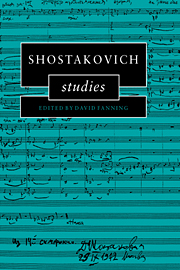Book contents
- Frontmatter
- Contents
- Acknowledgments
- 1 Introduction. Talking about eggs: musicology and Shostakovich
- 2 Public lies and unspeakable truth interpreting Shostakovich's Fifth Symphony
- 3 Form in Shostakovich's instrumental works
- 4 Russian theorists on modality in Shostakovich's music
- 5 The cycle of structure and the cycle of meaning: the Piano Trio in E minor, Op. 67
- 6 Leitmotif in Lady Macbeth
- 7 From Lady Macbeth to Katerina Shostakovich's versions and revisions
- 8 The Golden Age: the true story of the première
- 9 ‘And art made tongue-tied by authority’ Shostakovich's song-cycles
- 10 A debt repaid? Some observations on Shostakovich and his late-period recognition of Britten
- 11 Shostakovich and Schnittke: the erosion of symphonic syntax
- Index
3 - Form in Shostakovich's instrumental works
Published online by Cambridge University Press: 22 October 2009
- Frontmatter
- Contents
- Acknowledgments
- 1 Introduction. Talking about eggs: musicology and Shostakovich
- 2 Public lies and unspeakable truth interpreting Shostakovich's Fifth Symphony
- 3 Form in Shostakovich's instrumental works
- 4 Russian theorists on modality in Shostakovich's music
- 5 The cycle of structure and the cycle of meaning: the Piano Trio in E minor, Op. 67
- 6 Leitmotif in Lady Macbeth
- 7 From Lady Macbeth to Katerina Shostakovich's versions and revisions
- 8 The Golden Age: the true story of the première
- 9 ‘And art made tongue-tied by authority’ Shostakovich's song-cycles
- 10 A debt repaid? Some observations on Shostakovich and his late-period recognition of Britten
- 11 Shostakovich and Schnittke: the erosion of symphonic syntax
- Index
Summary
Dmitri Shostakovich is among those who represent a clearly defined and necessary line in the evolutionary flow of twentieth-century music. The idea of this artistic trend is fused with its embodiment in the musical forms of the classical tradition, which externally has something in common with neoclassicism. The influence of neoclassicism on Shostakovich manifests itself in his quotations of some of the idioms of the musical language of the baroque or the Viennese classics, especially their melodies and stylistic forms – for example in the First Piano Concerto and the first movement of the Sixth Symphony; and the second movement of the Second String Quartet ends with a quotation of the standard formula for a cadence of baroque recitative. The influence also shows in his addressing typical polyphonic forms of the pre-classical style, in particular the fugue and passacaglia.
Strictly speaking this is not a neoclassical but a neobaroque attitude; but these are frequently not differentiated. And the influence of neoclassicism is not contradicted by the fact that Shostakovich's thinking is firmly based on forms which had grown up among the great Viennese classics such as Haydn, Mozart and Beethoven, which in the context of the twentieth century is not so much neoclassicism as ‘classicity’ or (classical) tradition. Many composers of the twentieth century set out on their creative path in this channel of tradition. The direction in which they headed after that was a matter of fate. Shostakovich, having tasted the temptations of New Music in the twenties, deliberately turned thereafter towards the world of traditional forms. The point of this path was ‘to be old in a new way’.
- Type
- Chapter
- Information
- Shostakovich Studies , pp. 57 - 75Publisher: Cambridge University PressPrint publication year: 1995
- 1
- Cited by



